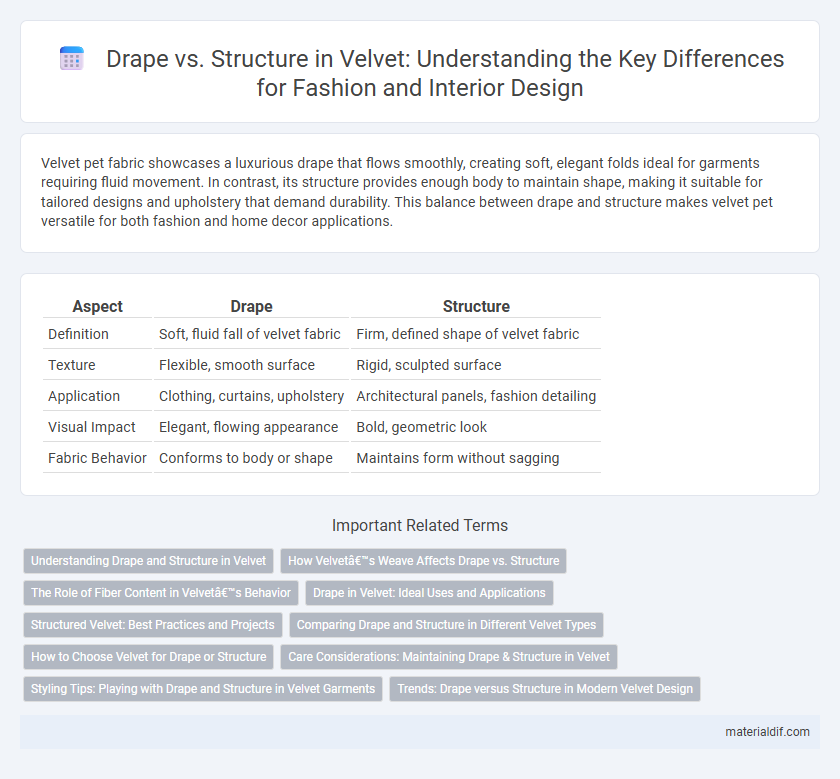Velvet pet fabric showcases a luxurious drape that flows smoothly, creating soft, elegant folds ideal for garments requiring fluid movement. In contrast, its structure provides enough body to maintain shape, making it suitable for tailored designs and upholstery that demand durability. This balance between drape and structure makes velvet pet versatile for both fashion and home decor applications.
Table of Comparison
| Aspect | Drape | Structure |
|---|---|---|
| Definition | Soft, fluid fall of velvet fabric | Firm, defined shape of velvet fabric |
| Texture | Flexible, smooth surface | Rigid, sculpted surface |
| Application | Clothing, curtains, upholstery | Architectural panels, fashion detailing |
| Visual Impact | Elegant, flowing appearance | Bold, geometric look |
| Fabric Behavior | Conforms to body or shape | Maintains form without sagging |
Understanding Drape and Structure in Velvet
Velvet exhibits a unique balance between drape and structure, determined by its dense pile and fabric weight. Its natural softness allows for elegant, fluid draping, making it ideal for garments and upholstery that require a luxurious flow. The fabric's inherent structure originates from the woven base and pile density, providing enough support to maintain shape in tailored designs without sacrificing comfort.
How Velvet’s Weave Affects Drape vs. Structure
Velvet's unique weave, characterized by densely packed cut pile yarns on a woven base, significantly influences its drape and structure. The tight weave and plush pile create a fabric with substantial weight and body, giving it a rich, flowing drape that maintains elegant folds while offering enough firmness for structured silhouettes. Variations in pile density and base fabric composition determine velvet's balance between softness and rigidity, making some velvets ideal for fluid draping and others better suited for tailored, structured garments.
The Role of Fiber Content in Velvet’s Behavior
Fiber content significantly influences velvet's drape and structure, with natural fibers like silk offering a soft, fluid drape, while synthetic fibers such as polyester provide more rigidity and shape retention. The blend of fibers affects velvet's weight, texture, and durability, impacting whether it hangs smoothly or maintains a structured form. Understanding fiber content is essential for selecting velvet suited for specific applications requiring either elegance in flow or architectural definition.
Drape in Velvet: Ideal Uses and Applications
Velvet's rich texture and natural drape make it ideal for luxurious curtains, upholstery, and evening wear where fluidity and softness are prized. The fabric's weight and pile create a supple fall that enhances the elegance of draped garments and window treatments, allowing for graceful folds and a plush appearance. Velvet's drape is especially favored in designs requiring movement and comfort, such as flowing gowns, decorative cushions, and soft furnishings.
Structured Velvet: Best Practices and Projects
Structured velvet offers durability and form retention, making it ideal for upholstery and tailored fashion designs where shape is essential. Designers recommend using heavy-weight velvet with a tight weave to achieve clean lines and prevent sagging in structured applications. Notable projects featuring structured velvet include luxury furniture collections and high-end eveningwear, highlighting its versatility and elegant finish.
Comparing Drape and Structure in Different Velvet Types
Velvet types differ significantly in their drape and structure, with silk velvet offering a fluid, soft drape ideal for elegant gowns, while cotton velvet provides a heavier, more structured form suited for upholstery and tailored garments. Crushed velvet exhibits a textured, dynamic drape that creates visual depth, contrasting with the firm, dense weave of polyester velvet that maintains shape and rigidity. Understanding these variations helps designers choose the appropriate velvet type to balance aesthetic appeal with functional requirements.
How to Choose Velvet for Drape or Structure
When choosing velvet for drape, prioritize fabrics with a lightweight weave and a soft hand that allow fluid movement and graceful folds; silk velvet and rayon velvet are excellent choices due to their luxurious sheen and supple texture. For structured applications, select heavier velvets like cotton velvet or polyester blends with a denser weave that maintain shape and provide durability for garments or upholstery requiring firm form. Consider the pile height and backing material, as shorter piles and reinforced backings enhance structure, while longer piles contribute to smooth draping.
Care Considerations: Maintaining Drape & Structure in Velvet
Velvet requires specific care to maintain its characteristic drape and structure, with gentle handling and proper storage being essential to avoid crushing or matting. Using a steamer rather than a hot iron helps to preserve the fabric's pile and softness while preventing permanent creases or damage to the fibers. Regularly brushing with a soft clothes brush and storing velvet garments on padded hangers supports the fabric's luxurious texture and elegant fall.
Styling Tips: Playing with Drape and Structure in Velvet Garments
Velvet garments offer a luxurious texture that enhances both drape and structure for versatile styling options. Opt for velvet dresses or skirts with soft drape to create fluid movement and an elegant silhouette, ideal for evening wear or romantic outings. Structured velvet blazers and pants emphasize sharp lines and tailored fits, perfect for a polished, sophisticated look that balances richness with modern edge.
Trends: Drape versus Structure in Modern Velvet Design
Modern velvet design trends highlight a distinctive shift between drape and structure, where soft, flowing velvet fabrics emphasize elegance and comfort in contemporary fashion and interiors. Structured velvet pieces showcase sharp tailoring and architectural silhouettes, adding a bold, refined statement to luxury garments and upholstery. Designers are increasingly balancing these elements, blending rich textures with innovative forms to meet evolving consumer preferences in velvet aesthetics.
Drape vs Structure Infographic

 materialdif.com
materialdif.com